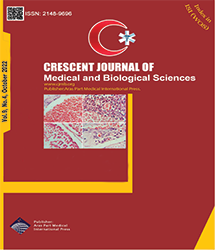| Original Article | |
| Evaluation of Testosterone, Blood Antioxidants, and Histopathological Changes Following Chemical Castration With Calcium Chloride in Rats | |
| Mehdi Hami1, Abbas Veshkini1, Alireza Jahandideh1, Siamak Mashhadi Rafiee1, Pejman Mortazavi2 | |
| 1Department of Clinical Sciences, Science and Research Branch, Islamic Azad University, Tehran, Iran 2Department of Pathobiology, Science and Research Branch, Islamic Azad University, Tehran, Iran |
|
|
CJMB 2022; 9: 207-212 DOI: 10.34172/cjmb.2022.34 Viewed : 4045 times Downloaded : 2920 times. Keywords : Calcium chloride, Chemical castration, Antioxidant, Histopathology, Testosterone, Rat |
|
| Full Text(PDF) | Related Articles | |
| Abstract | |
Objectives: Castration is one of the most common methods of contraception in animals. This method can prevent animals from contracting various diseases, such as testicular tumors, and prevent the overgrowth of animal populations. Materials and Methods: In this experiment, 10 adult and clinically healthy male Wistar rats weighing approximately 250-200 g were divided into two equal groups of control and treatment (n=5 in each). In the control group, normal saline and in the treatment group, 20% calcium chloride was injected into the testicular tissue. Blood samples were taken at the beginning and end of the experiment (day 21) and the superoxide dismutase (SOD), glutathione peroxidase (GPx), and testosterone levels were measured. Then, the tissue samples of testis were evaluated on days 7, 14, and 21. Results: On day 21, SOD and GPx enzymes significantly increased in the treatment group compared to day zero (P = 0.01). However, calcium chloride injection reduced the mean testosterone levels on day 21 compared to day zero (P = 0.06). Meanwhile, the mean number of sperms in the right testis of treated mice significantly decreased (P = 0.03). Seminiferous tubule necrosis significantly increased on day 7, neutrophil infiltration significantly increased on days 7 and 14, and calcification significantly increased on days 7 and 21 (P < 0.01). Conclusions: Although chemical sterilization using 20% calcium chloride can lead to testicular degeneration, it is not a recommended method because it does not reduce testosterone and activates oxidative stress biomarkers. However, the negative effects might be eliminated in future studies using some substances such as tannic acid. |
Cite By, Google Scholar
Google Scholar
PubMed
Online Submission System
 CJMB ENDNOTE ® Style
CJMB ENDNOTE ® Style
 Tutorials
Tutorials
 Publication Charge
Medical and Biological Research Center
About Journal
Publication Charge
Medical and Biological Research Center
About Journal
Aras Part Medical International Press Editor-in-Chief
Arash Khaki
Deputy Editor
Zafer Akan



















